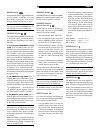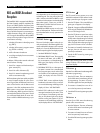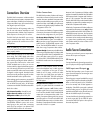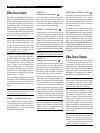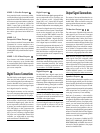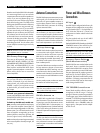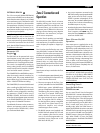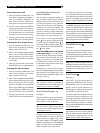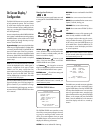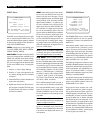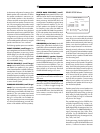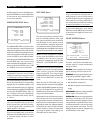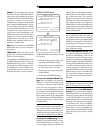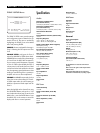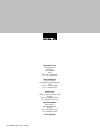
26
RSX-1065 Surround Sound Receiver
INPUT Menu
INPUT SETUP
LISTEN: Video 2
INPUT LABEL: _ _ _ _ _ _ _
INPUT: Coaxial 1
SURR MODE: Dolby 3 Stereo
ENT KEY=MAIN MENU UP KEY=up
+/– KEY=change DWN KEY=down
The INPUT menu configures the source inputs
and is reached from the MAIN menu. The
screen provides the following options, selected
by placing the highlight on the desired line
using the UP/DOWN buttons:
LISTEN: changes the current listening input
source (CD, TUNER, TAPE, VIDEO1, VIDEO2,
VIDEO3, VIDEO4, VIDEO5).
INPUT LABEL: The labels for the five VIDEO
inputs can customized (not available for the
TUNER, CD, and TAPE inputs). Place the high-
light on this line to call up a sub-menu that al-
lows you to change the seven-character label
for the current VIDEO source. To change the
label:
1. Press the +/– keys to begin labeling.
2. Press the +/– keys to change the first let-
ter, scrolling through the list of available
characters.
3. Press the ENT key to confirm that letter and
move to the next position.
4. Repeat steps 2 and 3 until all five charac-
ters have been completed. The final press
of the ENT button will save the new label
and exit the sub-menu.
INPUT: selects which physical input connec-
tion to use as the default for the source dis-
played in the first line of the menu. The op-
tions are ANALOG inputs, two OPTICAL digital
inputs (OPTICAL 1& 2), and three COAXIAL
digital inputs (COAXIAL 1 – 3). When a digi-
tal input is selected, the unit will check for a
digital signal when the INPUT SOURCE but-
ton is pressed. If no digital signal is present,
the unit will automatically revert to the ana-
log input. When an ANALOG input is selected,
the unit will not access a digital signal, even
though one may be present at the digital in-
put; thus, the ANALOG setting forces the unit
to use accept only an analog signal. Assign-
ing a digital input (with its auto-sensing) is the
preferred configuration for digital source in-
puts such as DVD players.
NOTE
: If a source connected to a digital input
is selected, that signal will automatically be
sent to both digital outputs for recording.
SURR MODE: selects the default surround
sound mode for the input shown at the top of
the menu. The default setting will be used unless
the source material triggers automatic decoding
of a particular type or unless the default set-
ting is overridden by the front panel or remote
surround buttons. Options are: DTS, DTS-ES
Matrix 6.1, DTS-ES Discrete 6.1, Dolby Digi-
tal, Dolby Pro Logic II, Dolby 3-Stereo, Music
1, Music 2, Music 3, Music 4, 5CH Stereo,
7CH Stereo, PCM 2-Channel, Dolby Digital
2-ch Stereo, HDCD, and Stereo.
This is a default setting for each input and, in
some cases, can be manually overridden by
the front-panel MODE buttons or the SUR+
button on the remote. See the SURROUND
SOUND CONTROLS section of this manual
for mor information on which settings can be
overridden.
NOTE
: We suggest that you return to this menu
after connecting each source component to
properly configure that source.
To return to the MAIN menu, press the EN-
TER button. Press the MENU key on the remote
to cancel the menu display and return to nor-
mal operation.
SPEAKER SETUP Menu
SPEAKER SETUP
FRONT: Large
CENTER: Large
SURROUND: Large
CENTER BACK: Large
SUBWOOFER: Yes
CB SPKR SEL: 1 SPEAKER
ENT KEY=MAIN MENU UP KEY=up
+/– KEY=change DWN KEY=down
The SPEAKER SETUP menu is used to config-
ure the RSX-1065 for use with your specific
loudspeakers. The menu is accessed from the
MAIN menu.
Home theater speaker systems vary in their
size and performance, particularly in bass
output. Surround sound processors feature
steering logic which sends bass information
to the speaker(s) best able to handle it – sub-
woofers and/or large speakers. For optimum
performance, you must tell the RSX-1065 what
types of speakers are in your system.
The following configuration instructions refer
to LARGE and SMALL speakers, referring more
to their bass performance than physical size.
A full-range speaker with extended bass re-
sponse is considered LARGE. A compact
speaker with limited bass response or power
handling is considered SMALL.
As a general rule, the system will redirect bass
information away from SMALL speakers and
send it to the LARGE speakers and/or the
SUBWOOFER in your system.
Things become more complex with a sub-
woofer. For example, the system will gener-
ally not redirect bass information away from
a LARGE speaker to the subwoofer. Thus, you
must decide if you want a particular speaker
to play the deep bass or whether the deep
bass should be sent to the subwoofer. If you
have a subwoofer, you might decide to send
all of the bass to it, regardless of how capable
the other speakers in the system may be. In
this case, you would tell the RSX-1065 that all
of your speakers are SMALL, without regard
to how big they may actually be.



